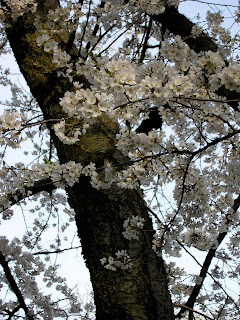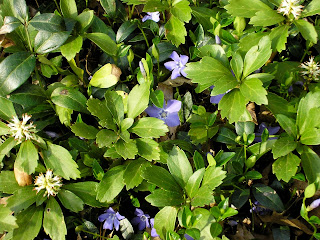At the northern end of the Charter Oak townhouse development is this beautiful grouping of magnolias, with a white star magnolia (Magnolia stellata, see Virginia Tech fact sheet) flanked by two pinkish saucer magnolias (M. x soulangiana, see Virginia Tech fact sheet) and backed by hollies.
A closer look at the star magnolia, with a Norway spruce (Picea abies) at the left edge of the image.
The saucer magnolia blossoms (slightly bleached by the flash in this image) have not yet actually opened up. In many years they are damaged by frost and wilt before opening, but it appears this year they survived our recent near-frost unscathed.
In the central lawn of the Charter Oak townhouses is this staple of early Reston springs, the forsythia (Forsythia spp., see the Virginia Tech fact sheet).
A close-up of the forsythia flowers.
Splashes of bright yellow are supplied in springtime as well by daffodils (Narcissus spp.), such as this bunch near the entrance to the Charter Oak townhouse development. There are apparently more than 50 species of daffodils (see this Wikipedia article); maybe next year I'll pay more attention to their variety.
Across North Shore Drive, at the southern entrance to the Ivy Oak townhouse development, is this cherry tree now in bloom - I believe this is a Yoshino cherry (Prunus x yedoensis, see the Virginia Tech fact sheet), like the ones that blanket the Tidal Basin in Washington.
Ah, what pretty flowers!
Back at the Charter Oak townhouses, there is this cherry tree that is still getting ready to bloom, with a pinker color to the blossoms. This may be the Akebono cultivar of the Yoshino cherry. (Note added April 4: the more I think about it and compare it with other cheriies in Reston, the more I think this might actually be a purple-leaf plum, Prunus cerasifera).
A close-up of the flowers of this tree, showing very slightly rose petals sitting in a darker pink calyx.
And finally, if one shifts one's attention from the glorious flowering trees to the ground cover, one can find periwinkles blooming. Not quite sure whether these are greater periwinkle (Vinca major) or lesser periwinkle (V. minor), and I have no idea what the other flowering ground-cover plant in this picture is.










